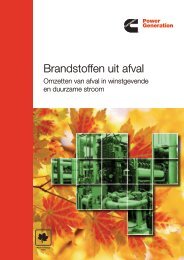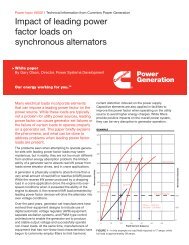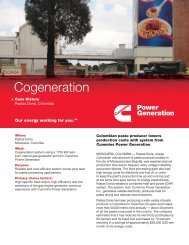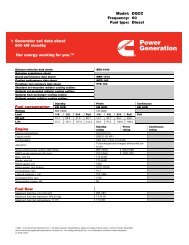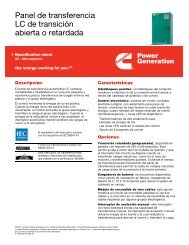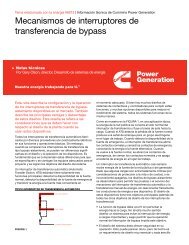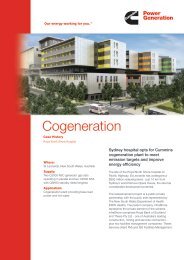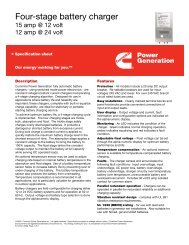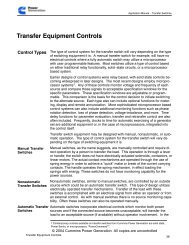appendix
appendix
appendix
You also want an ePaper? Increase the reach of your titles
YUMPU automatically turns print PDFs into web optimized ePapers that Google loves.
Application Manual – Liquid Cooled Generator Sets<br />
APPENDIX E<br />
Maintenance<br />
and Service<br />
Daily<br />
Weekly<br />
Monthly<br />
A well–planned program of preventative maintenance and service should be integral to<br />
the design of an on–site power system. Failure of a standby generator set to start and<br />
run could lead to loss of life, personal injury, property damage, and loss of business<br />
income. Failure to start and run due to low battery charge because of improper<br />
maintenance is the most common type of failure. A comprehensive program carried out<br />
on a scheduled basis by qualified persons can prevent such failures and their possible<br />
consequences. The maintenance and service programs most generator set distributors<br />
offer on a contract basis should be considered. Typically, they include performance of<br />
scheduled maintenance, repairs, parts replacement, and service documentation.<br />
The maintenance schedule for prime power sets should be on the basis of running time,<br />
as published by the manufacturer. Since standby sets run infrequently, the maintenance<br />
schedule is usually in terms of daily, weekly, monthly, or longer term tasks. See the<br />
manufacturer’s instructions for details. In any case, scheduled maintenance should<br />
include:<br />
• Check for oil, coolant, and fuel leaks.<br />
• Check operation of the engine coolant heater(s). If the block is not warm, the heaters<br />
are not working and the engine might not start.<br />
• Check to see that the switchgear is in the AUTOMATIC position and the generator<br />
circuit breaker, if used, is closed.<br />
• Check engine oil and coolant levels.<br />
• Check the battery charging system.<br />
• Check for air cleaner restrictions.<br />
• Exercise the generator set by starting and running it for at least 30 minutes under not<br />
less than 30% rated load. Lower load levels are acceptable if the exhaust gas temperature<br />
reaches a level sufficient to prevent engine damage. See Table E–1 for<br />
minimum exhaust gas temperatures for Cummins engines. Check for unusual vibrations,<br />
noises, and exhaust, coolant and fuel leaks while the set is running. (Regular<br />
exercising keeps engine parts lubricated, improves starting reliability, prevents oxidation<br />
of electrical contacts, and consumes fuel before it deteriorates and has to be discarded.)<br />
• Check for radiator restrictions, coolant leaks, deteriorated hoses, loose and deteriorated<br />
fan belts, non–functioning motorized–louvers and proper concentration of<br />
engine coolant additives.<br />
• Check for holes, leaks, and loose connections in the air cleaner system.<br />
• Check fuel level and fuel transfer pump operation.<br />
• Check for exhaust system leaks and restrictions, and drain the condensate trap.<br />
• Check all meters, gauges, and indicator lamps for proper operation.<br />
• Check the battery cable connections and battery fluid level and recharge the batteries<br />
if specific gravity is less than 1.260.<br />
• Check for ventilation restrictions in the inlet and outlet openings of the generator.<br />
E–2 APPENDIX E<br />
Rev. Jan 2011




